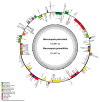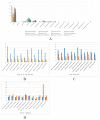Comparative Analysis of Chloroplast Genome of Meconopsis (Papaveraceae) Provides Insights into Their Genomic Evolution and Adaptation to High Elevation
- PMID: 38396871
- PMCID: PMC10888623
- DOI: 10.3390/ijms25042193
Comparative Analysis of Chloroplast Genome of Meconopsis (Papaveraceae) Provides Insights into Their Genomic Evolution and Adaptation to High Elevation
Abstract
The Meconopsis species are widely distributed in the Qinghai-Tibet Plateau, Himalayas, and Hengduan Mountains in China, and have high medicinal and ornamental value. The high diversity of plant morphology in this genus poses significant challenges for species identification, given their propensity for highland dwelling, which makes it a question worth exploring how they cope with the harsh surroundings. In this study, we recently generated chloroplast (cp) genomes of two Meconopsis species, Meconopsis paniculata (M. paniculata) and M. pinnatifolia, and compared them with those of ten Meconopsis cp genomes to comprehend cp genomic features, their phylogenetic relationships, and what part they might play in plateau adaptation. These cp genomes shared a great deal of similarities in terms of genome size, structure, gene content, GC content, and codon usage patterns. The cp genomes were between 151,864 bp and 154,997 bp in length, and contain 133 predictive genes. Through sequence divergence analysis, we identified three highly variable regions (trnD-psbD, ccsA-ndhD, and ycf1 genes), which could be used as potential markers or DNA barcodes for phylogenetic analysis. Between 22 and 38 SSRs and some long repeat sequences were identified from 12 Meconopsis species. Our phylogenetic analysis confirmed that 12 species of Meconopsis clustered into a monophyletic clade in Papaveraceae, which corroborated their intrageneric relationships. The results indicated that M. pinnatifolia and M. paniculata are sister species in the phylogenetic tree. In addition, the atpA and ycf2 genes were positively selected in high-altitude species. The functions of these two genes might be involved in adaptation to the extreme environment in the cold and low CO2 concentration conditions at the plateau.
Keywords: Meconopsis; chloroplast genome; high altitude adaptation; high variation region.
Conflict of interest statement
The authors declare no conflicts of interest.
Figures








Similar articles
-
Deciphering the complete chloroplast genome sequence of Meconopsis torquata Prain: Insights into genome structure, comparative analysis and phylogenetic relationship.Heliyon. 2024 Aug 13;10(16):e36204. doi: 10.1016/j.heliyon.2024.e36204. eCollection 2024 Aug 30. Heliyon. 2024. PMID: 39224270 Free PMC article.
-
Thirteen complete chloroplast genomes of the costaceae family: insights into genome structure, selective pressure and phylogenetic relationships.BMC Genomics. 2024 Jan 17;25(1):68. doi: 10.1186/s12864-024-09996-4. BMC Genomics. 2024. PMID: 38233753 Free PMC article.
-
The complete chloroplast genome of Meconopsis bella Prain 1894 (Papaveraceae), a high-altitude plant distributed on the Qinghai-Tibet plateau.Mitochondrial DNA B Resour. 2024 Jan 25;9(1):195-199. doi: 10.1080/23802359.2024.2306879. eCollection 2024. Mitochondrial DNA B Resour. 2024. PMID: 38282978 Free PMC article.
-
Comparison of Four Complete Chloroplast Genomes of Medicinal and Ornamental Meconopsis Species: Genome Organization and Species Discrimination.Sci Rep. 2019 Jul 22;9(1):10567. doi: 10.1038/s41598-019-47008-8. Sci Rep. 2019. PMID: 31332227 Free PMC article.
-
Complete chloroplast genome of Stephania tetrandra (Menispermaceae) from Zhejiang Province: insights into molecular structures, comparative genome analysis, mutational hotspots and phylogenetic relationships.BMC Genomics. 2021 Dec 6;22(1):880. doi: 10.1186/s12864-021-08193-x. BMC Genomics. 2021. PMID: 34872502 Free PMC article.
Cited by
-
The Complete Chloroplast Genome of Meconopsis simplicifolia and Its Genetic Comparison to Other Meconopsis Species.Genes (Basel). 2024 Oct 6;15(10):1301. doi: 10.3390/genes15101301. Genes (Basel). 2024. PMID: 39457425 Free PMC article.
-
Comparative Plastomics of Plantains (Plantago, Plantaginaceae) as a Tool for the Development of Species-Specific DNA Barcodes.Plants (Basel). 2024 Sep 25;13(19):2691. doi: 10.3390/plants13192691. Plants (Basel). 2024. PMID: 39409561 Free PMC article.
-
Deciphering the complete chloroplast genome sequence of Meconopsis torquata Prain: Insights into genome structure, comparative analysis and phylogenetic relationship.Heliyon. 2024 Aug 13;10(16):e36204. doi: 10.1016/j.heliyon.2024.e36204. eCollection 2024 Aug 30. Heliyon. 2024. PMID: 39224270 Free PMC article.
-
Identification of the UGT Family and Functional Validation of MwUGT2 in Meconopsis wilsonii.Plants (Basel). 2025 Mar 17;14(6):944. doi: 10.3390/plants14060944. Plants (Basel). 2025. PMID: 40265876 Free PMC article.
-
Insights into structure, codon usage, repeats, and RNA editing of the complete mitochondrial genome of Perilla frutescens (Lamiaceae).Sci Rep. 2024 Jun 17;14(1):13940. doi: 10.1038/s41598-024-64509-3. Sci Rep. 2024. PMID: 38886463 Free PMC article.
References
-
- Meger J., Ulaszewski B., Vendramin G.G., Burczyk J. Using reduced representation libraries sequencing methods to identify cpDNA polymorphisms in European beech (Fagus sylvatica L) Tree Genet. Genomes. 2019;15:7. doi: 10.1007/s11295-018-1313-6. - DOI
-
- Xiao W., Simpson B.B. A New Infrageneric Classification of Meconopsis (Papaveraceae) Based on a Well-supported Molecular Phylogeny. Syst. Bot. 2017;42:226–233. doi: 10.1600/036364417X695466. - DOI
MeSH terms
Supplementary concepts
Grants and funding
LinkOut - more resources
Full Text Sources
Miscellaneous

